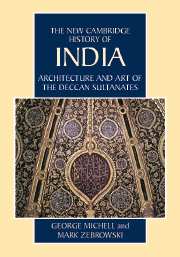Book contents
- Frontmatter
- Introduction
- 1 Historical framework
- 2 Forts and palaces
- 3 Mosques and tombs
- 4 Architectural decoration
- 5 Miniature painting: Ahmadnagar and Bijapur
- 6 Miniature painting: Golconda and other centres
- 7 Textiles, metalwork and stone objects
- 8 Temples
- 9 Conclusion
- Appendix: Dynastic Lists of Deccan Rulers
- Bibliographic Essay
- Bibliography
- Index
- Map of the Southern Deccan"
- Plate Section"
3 - Mosques and tombs
Published online by Cambridge University Press: 28 March 2008
- Frontmatter
- Introduction
- 1 Historical framework
- 2 Forts and palaces
- 3 Mosques and tombs
- 4 Architectural decoration
- 5 Miniature painting: Ahmadnagar and Bijapur
- 6 Miniature painting: Golconda and other centres
- 7 Textiles, metalwork and stone objects
- 8 Temples
- 9 Conclusion
- Appendix: Dynastic Lists of Deccan Rulers
- Bibliographic Essay
- Bibliography
- Index
- Map of the Southern Deccan"
- Plate Section"
Summary
The large number of relatively well-preserved mosques and tombs contrasts markedly with the dilapidation of the forts and palaces noted in chapter 2. Apart from the usual array of Jami mosques and lesser places of prayer in the principal cities of the Deccan, there is also an impressive series of tombs. Personal ambition on the part of sultans, their ministers and commanders accounts for a funerary tradition that often represents the Wnest architectural achievements of the period. Nowhere is this better demonstrated than at Bijapur and Aurangabad where royal mausoleums were conceived on the grandest possible scale. The direct involvement of patrons in such projects is almost always recorded on the monuments, with the result that religious architecture presents a relatively clear chronological pattern.
A characteristic feature of Deccan culture during these centuries is the abundance of saintly personalities, especially members of the Chishti and Naqshbandi orders, who gained status as spiritual advisors to the sultans and their families. The dargahs of the most important holy Wgures, originally Wnanced byroy al bequests, have been maintained through the centuries as popular places of worship and are active today. They continue to attract large crowds of pilgrims on the occasions of the Urs festivities celebrating the death anniversaries of the saints.
Keywords
- Type
- Chapter
- Information
- Architecture and Art of the Deccan Sultanates , pp. 63 - 114Publisher: Cambridge University PressPrint publication year: 1999
- 1
- Cited by



